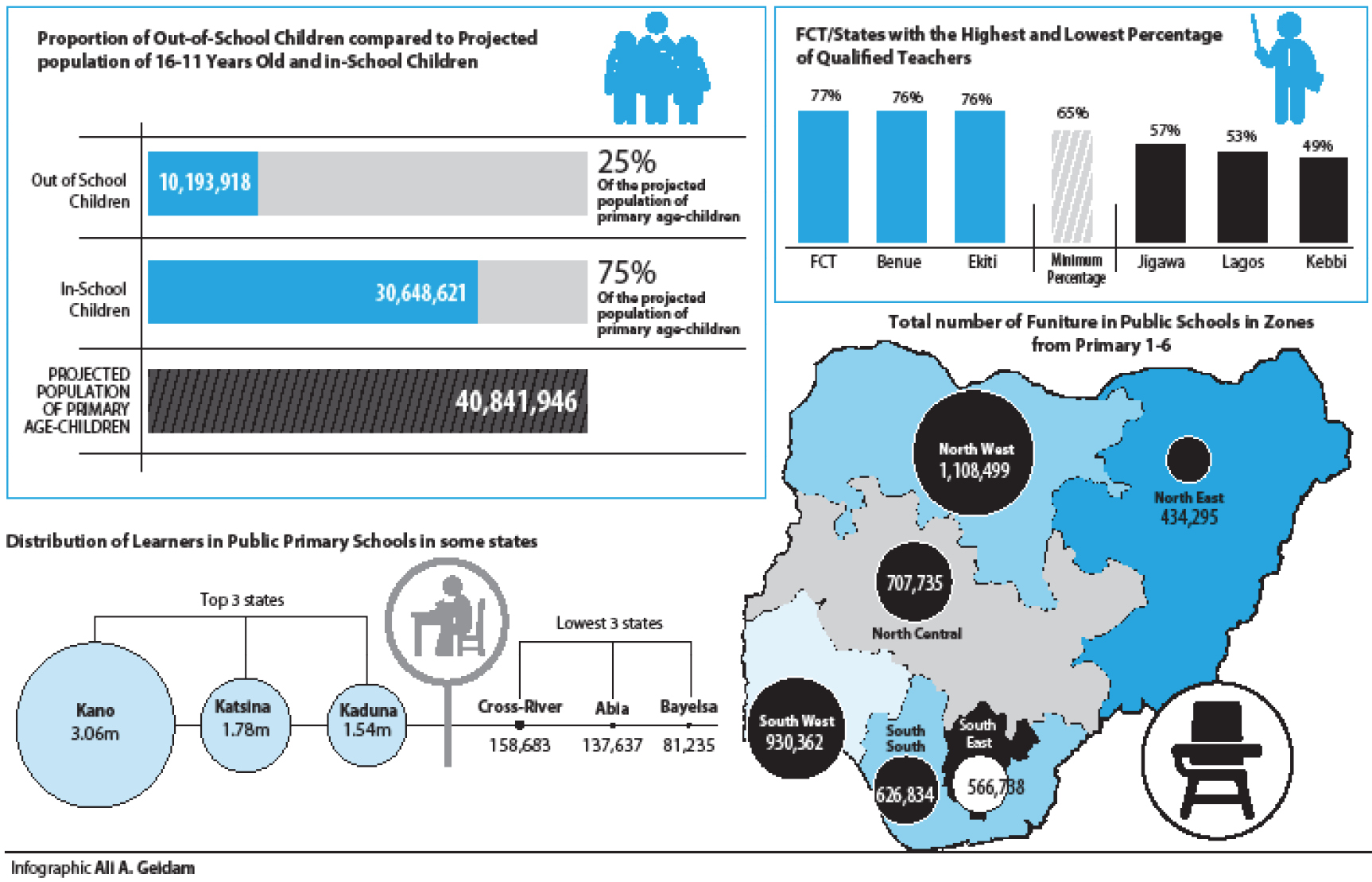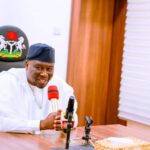Kebbi, Lagos and Jigawa states are on top of the list of states with unqualified teachers in public schools, the 2018 National Personnel Audit (NPA) report, shows.
The report, which was released by the Universal Basic Education Commission (UBEC), yesterday, indicates that pupils’ ability to learn in many states is being threatened by the lack of qualified teachers.
The report, which dwelt on public and private basic education schools across the country, was officially launched by President Muhammadu Buhari at the International Conference Centre, Abuja.
He was represented by the Minister of Education, Malam Adamu Adamu.
The report showed that there is currently a shortage of about 277,537 qualified teachers in basic education schools in Nigeria.
It, however, indicated that with 73 per cent, public schools have more qualified teachers than private schools that have 53 per cent across the levels of education.
The revelation came at a time the federal government revealed that it had disbursed over N153 billion to state governments in the last four years for the implementation of the UBE in the country.
Content of the report
The report, which states that the efficiency of teaching and learning is measured by assessing the quality of teachers in the school system, shows that as many as 14 states have lower percentage of qualified teachers than the national average of 65 per cent.
A qualified teacher at the basic level is one that possesses Nigerian Certificate of Education (NCE), or degree in education, or degree in another subject with either NCE or certificate in education.
Those with the lowest percentage of qualified teachers are Kebbi with 49 per cent; Lagos, 53 per cent; Jigawa, 57 per cent; Gombe 60 per cent; Zamfara, 62 per cent; Imo 63 per cent and Abia 64 per cent.
Oyo State with 77 per cent of qualified teachers has the highest in the country followed by the FCT, Benue and Plateau states with 76 per cent each.
A state-by-state analysis of the teaching staff in public primary schools indicates that Kano with 65,173 teachers has the highest, followed by Lagos (59,906), Oyo (37,232), Kaduna (36,019) and Niger (35,899).
Bayelsa has the lowest number of staff with 9,986 and more than 35 per cent in public schools.
According to the report, there was a deficit of 135,319 teachers at the Early Childhood Care Development Education; a deficit of 139,772 in primary schools and 2,446 shortage in Junior Secondary Schools across the nation.
FG’s position
Speaking at the event, Malam Adamu Adamu said budgetary allocations for basic education between 2015 and 219 were released to UBEC at the appointed time.
“Over N173 billion has been released to UBEC as matching grants out of which N153 billion was disbursed to the state governments,” he said.
He stated that the sum of N34 billion was released to states for Teacher Professional Development while over N8 billion was released to states for the education of children with special needs.
Malam Adamu said when it became apparent that most state governments were not willing to pay their counterpart funds in order to access the matching grant from UBEC, President Buhari approved the deduction of N71 billion from source from the share of states’ of the Paris Club refund.
“This was paid into UBEC account with the Central Bank of Nigeria. In June 2019, UBEC fulfilled its own matching grant obligation by releasing the sum of N142 billion to respective states for the implementation of basic education,” he said.
He commended UBEC, World Bank and other critical stakeholders that contributed to the success of the 2018 National Personnel Audit exercise, saying the government would come up with policies on key findings and recommendations of the NPA report.
He, however, noted that the report was not perfect, urging various levels of government and stakeholders to fill the gaps so as to ensure improved basic education delivery in the country.
In his remarks, the Executive Secretary of UBEC, Dr Hamid Bobboyi, said the report, which captured the situation in public, private and faith-based basic schools, was meant to ensure planning and effective management of the sub-sector.
He said through the 2018 National Personnel Audit, the commission acquired the Global Position System (GPS) coordinates of all schools in the country covered by the census.
Bobboyi added that the geospatial data generated had proven exceptionally useful in building a Geographic Information System (GIS), to support school mapping and other applications.
He, however, explained that despite the success recorded in the report, there is still room for improvement because there are data gaps which must be taken care of to sustain the educational data bases.
School enrolment
National level analysis of the data in the NPA showed that out of the projected 40,841,946 number of 6-7 years old children, 30,648,028 have been enrolled in schools which account for 75 per cent. The data estimated that 10,193,918 of primary age children are not in school.
“In practical terms, one out of four primary age children in the country was out of school and for three children in school, one child was out of school,” the report said.
State level analysis revealed that Kano, with 989,234 school age children not attending school topped the chart of out-of-school children (OOSC).
In three of the least performing states of Yobe, Taraba and Zamfara, four out of 10 children are out of school.
Also in six states of Sokoto, Borno, Rivers, Plateau, Benue and Nasarawa, out of three children, one is not in primary school. In the 10 states of Adamawa, Bauchi, Kogi, Niger, Jigawa, Ebonyi, Bayelsa, Edo, Osun and Ogun, one in four children is out of school.
Also in 11 states namely: Abia, Akwa Ibom, Delta, Enugu, Gombe, Kaduna, Kano, Katsina, Kebbi, Kwara and Oyo, at least one in four children is out of school.
Similarly, only four states and the FCT have less than 10 per cent of their primary school age children out of school. Anambra has 15 per cent of school age children out of school, Imo (17 per cent), Ekiti (17 per cent) and Lagos (19 per cent).
In public schools across the states, the proportion of schools with computers varied from 0.46 per cent in Ebonyi to 75.59 per cent in Ekiti while the proportion of schools with laboratories varied from 3.16 per cent in Akwa Ibom to 0.07 per cent in Osun.
Ekiti State has the highest proportion of schools with libraries with 36.06 per cent while Yobe State with 1.83 per cent is the lowest.
Edo State has the largest proportion of schools with playground (75.48 per cent) while Akwa Ibom State with 1.11 per cent has the smallest.
Again, the proportion of schools with incinerators varied from 18.17 per cent in Lagos to 0.040 per cent in Taraba.
In terms of enrolment, the report indicates that Kano State, with three million learners has the highest number of pupils in public schools while states that have above one million children are Akwa Ibom, Kaduna, Katsina and Oyo.
Bayelsa with 81,235 has the lowest number of children in public schools.
More learners are found in rural public primary schools than in urban schools in all states except in Borno, Ekiti, Lagos, Ogun, Oyo and Osun.
Lagos with 80.32 per cent has the highest percentage of learners in urban public schools, while Bayelsa with 83.13 per cent has the highest percentage of learners in rural schools.
In Borno State, as a result of Boko Haram insurgency, many families from rural areas have moved to the state capital thereby swelling the population of learners there.
The report shows that the North West has the highest number of public primary schools with 20,159 while South East with 5,491 has the lowest.
The report estimates that the total number of classrooms required for public primary schools nationally stands at 639,564, but the total number of available classrooms is 406,778 leaving a deficit of 232,786.
However, only 208,840 of the 406,778 available classrooms representing 51 per cent are in good condition.
In terms of Learner Classroom Ratio (LRC) by zone, the North Central has the lowest at 32 learners to a classroom, followed by the South East and South South with 45 and 46 respectively.
The North West has the highest LCR at 77 learners to a classroom, followed by the North East at 60 learners per classroom.

 Join Daily Trust WhatsApp Community For Quick Access To News and Happenings Around You.
Join Daily Trust WhatsApp Community For Quick Access To News and Happenings Around You.


